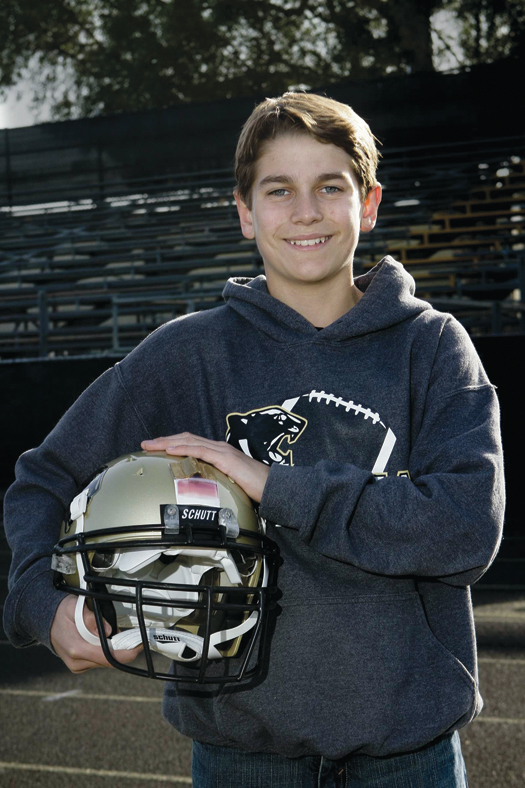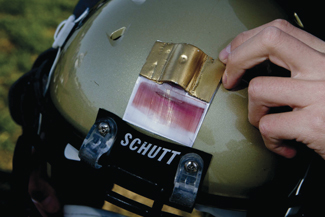 Braeden Benedict poses for a portrait at Palos Verdes Peninsula High School in Rolling Hills Estates, Calif., on Feb. 28, 2012. Benedict won a national science award for a device (below) that can be fitted into youth football and lacrosse helmets to help identify potential concussions. He has applied for a patent. (Photos by Anne Cusack/Los Angeles Times/MCT)
Braeden Benedict poses for a portrait at Palos Verdes Peninsula High School in Rolling Hills Estates, Calif., on Feb. 28, 2012. Benedict won a national science award for a device (below) that can be fitted into youth football and lacrosse helmets to help identify potential concussions. He has applied for a patent. (Photos by Anne Cusack/Los Angeles Times/MCT)
In the Southern California coastal community of Palos Verdes, one high school student is developing devices that could help thousands of young people avoid serious sports-related brain injuries.
Since 2012, 16-year-old Braeden Benedict, a rising junior at Palos Verdes Peninsula High School, has developed two devices that are capable of detecting concussions in athletes.
A football player himself, Benedict has seen several friends and teammates experience concussions and accompanying symptoms. One friend suffered a concussion during a football game that went undiagnosed for weeks. In his video for the Discovery Education 3M Young Scientist Challenge, Benedict stated it was not until the friend complained of an inability to focus and was failing all of his classes that the concussion was diagnosed. Benedict knew that better sideline evaluation tools were needed to detect serious brain injuries.
According to a 2012 article in the Los Angeles Times by David Wharton, Benedict found that expensive tracking systems had been developed for use on professional teams. Benedict felt that in order to market his device to youth and high school football teams without big budgets he needed to make it affordable.
In the fall of 2012, Benedict received national recognition for his development of the “Detector Protector,” an adhesive patch filled with colored liquid that sticks to the front of the helmet. As Benedict explained in his winning video for the 3M Challenge, when the head receives an impact greater than 75 G-forces, the surface tension of a colored liquid held in suspension breaks, releasing a red dye inside the otherwise transparent patch. Most importantly, the coach can see this and immediately get the player out of the game for evaluation. After placing first in the 3M Challenge, Benedict received $25,000 to continue his research.
As Wharton notes, Benedict’s invention was inspired by a technology used in shipping to detect if a crate had been handled roughly enough to damage its contents.
The device is not without its flaws. Research has shown that different players experience concussions at different forces of impact. For example, one player might experience an injury at 65 G-forces, while another might not have any effects until 90 G-forces. Thus, figuring out the impact level that will trigger the red dye to be released could be an issue, as Wharton cites after speaking with Dr. David Kruse, formerly of UC Irvine’s Orthopaedic and Sports Medicine Center. However, Benedict feels that it is important to have some form of detection, even if not perfectly accurate.

“It is better to have false alarms than to not detect a concussion,” Benedict stated.
This year, Benedict developed a second sensor device that takes a different approach: By modifying a commercially available brain game that measures brain-wave activities, he has developed a simple, low-cost electroencephalogram, or EEG, device that measures concussions with more accuracy.
“In the game you try to levitate a ball with your brain waves. I thought, could we use this for concussion research?” recalled Benedict.
When a player wears the EEG headset, data is transmitted to a micro controller running with software he wrote himself. Results are read through an LCD display and a bio-feedback LED array.
“The idea behind [my device] is that it’s simple, and you’d have it on the sidelines and test [the players] right there,” said Benedict.
In a video created last May for the 2013 Google Science Fair, Benedict explains his new device. Although it has only been a year since the development of the “Detector Protector,” he and his research have grown in that same classic growth spurt teens have between freshman and sophomore year. Benedict is taller, his shoulders are broad, his voice has dropped an octave, and his work has progressed significantly.
To create his control group, Benedict tested 63 subjects from his Lacrosse team as well as other student athletes at his high school. They wore the device, and he took a reading of their brain waves while they were focused (beta brain waves) and then relaxed (alpha brain wave). Five of the subjects later received concussions as a result of sporting activities. Benedict found that attention values for these concussed subjects were lowered. Beta and alpha brain waves were reduced following a concussion and then retuned to normal levels as the subjects recovered during a period of time spanning 10 to 45 days.
The most interesting and significant finding, however, was that control subjects who had a concussion history who were not currently experiencing symptoms showed reduced beta waves and lowered attention values while relaxing– just like subjects who currently had concussions.
Benedict is currently working to incorporate bluetooth capabilities into the EEG detector to allow the device to transmit results to a smartphone. He will continue testing and refining his device this fall, when football seasons commences.
“Football is the time for concussions. It’s concussion season,” he said.
Although the project was not a finalist in the Google Science Fair, Benedict continues his work hoping, as he concludes in his video, that his device might one day be a simple and affordable sideline concussion test.



























